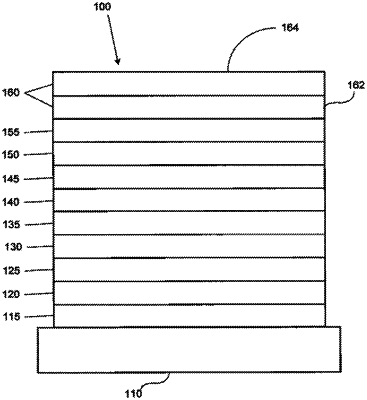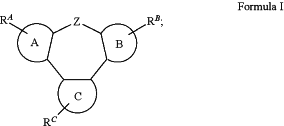| CPC C07F 15/0033 (2013.01) [H10K 85/342 (2023.02); H10K 50/12 (2023.02)] | 17 Claims |

|
1. A compound comprising a first bidentate ligand LA, wherein LA comprises a structure of Formula I;
 wherein Z is selected from the group consisting of O, S, NR, BR, CRKRL, SiRKRL, —CRKRLCRMRN—, —SiRKRLSiRMRN—, —CRKRLO—, —SiRKRLO—, and —CRK═CRL—;
wherein ring A, ring B, and ring C are each independently a 5-membered carbocyclic ring, 5-membered heterocyclic ring, 6-membered carbocyclic ring or 6-membered heterocyclic ring;
wherein LA is coordinated to a metal M forming a 5-membered or 6-membered chelate ring;
wherein M is selected from the group consisting of Ir, Pt, Pd, Ru, Rh, Os, Re, Cu, Ag, and Au;
wherein RA, RB, and RC each represent mono to the maximum allowable substitution, or no substitution;
wherein each R, RK, RL, RM, RN, RA, RB, and RC is independently a hydrogen or a substituent selected from the group consisting of deuterium, halogen, alkyl, cycloalkyl, heteroalkyl, heterocycloalkyl, arylalkyl, alkoxy, aryloxy, amino, silyl, boryl, alkenyl, cycloalkenyl, heteroalkenyl, alkynyl, aryl, heteroaryl, acyl, carboxylic acid, ether, ester, nitrile, isonitrile, sulfanyl, sulfinyl, sulfonyl, phosphino, and combinations thereof;
wherein M is optionally coordinated to one or more other ligands;
wherein any two substituents are optionally joined or fused together to form a ring; and
with the provision that LA does not comprise the following structure:
 with the provision that when M forms direct bonds to RA and ring A or when M forms direct bonds to RB and ring B, then Z is selected from the group consisting of NR, BR, CRKRL, SiRKRL, —CRKRLCRMRN—, —SiRKRLSiRMRN—, —CRKRLO—, —SiRKRLO—, and —CRK═CRL;
with the provision that when M forms direct bonds to ring A and ring C, or when M forms direct bonds to ring B and ring C, then Z does not represent CH2; and
with the provision that when Z is —CRK═CRL and RK and RL join to form a six-membered aryl or heteroaryl ring, then at least one of conditions (a) to (c) is satisfied:
(a) the ligand LA forms a chelating ring with M by two direct bonds: one from ring C, and the other from ring A or ring B;
(b) at least two of rings A, B, and C are heteroaryl; or
(c) at least one of ring A, ring B, or ring C is each independently a 5-membered ring;
with the provision that when Z is NR with R being phenyl or pyridyl, LA does not coordinate to M by a direct bond to R.
|